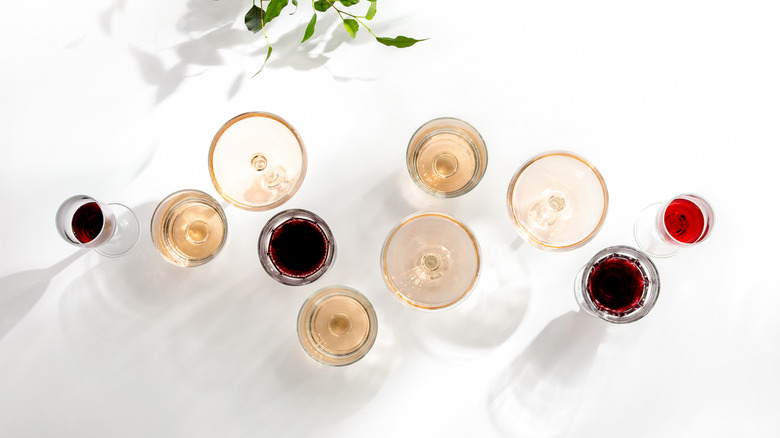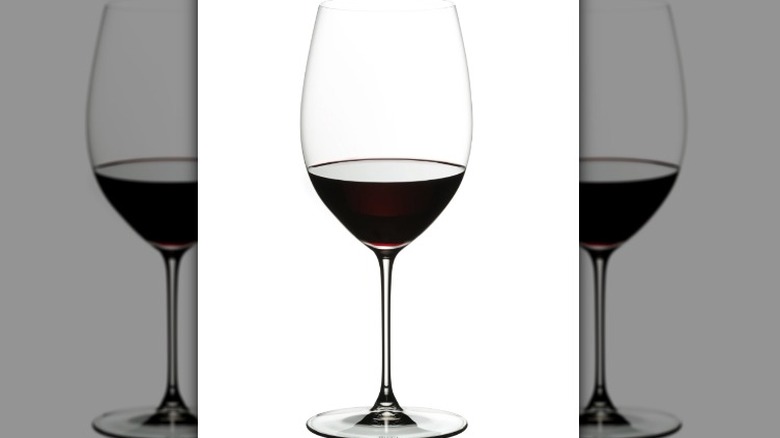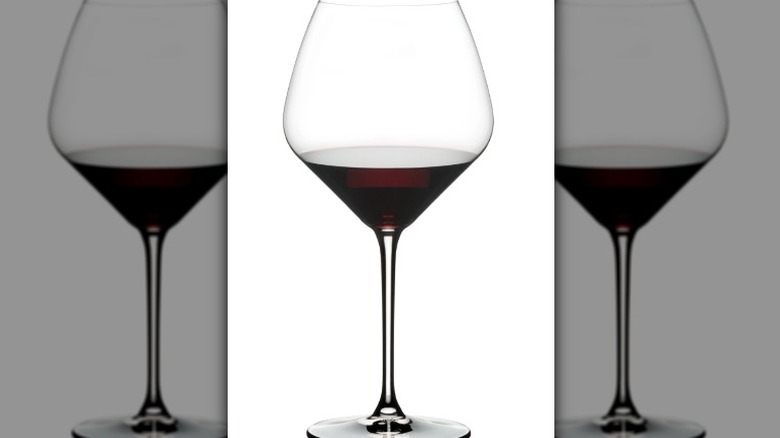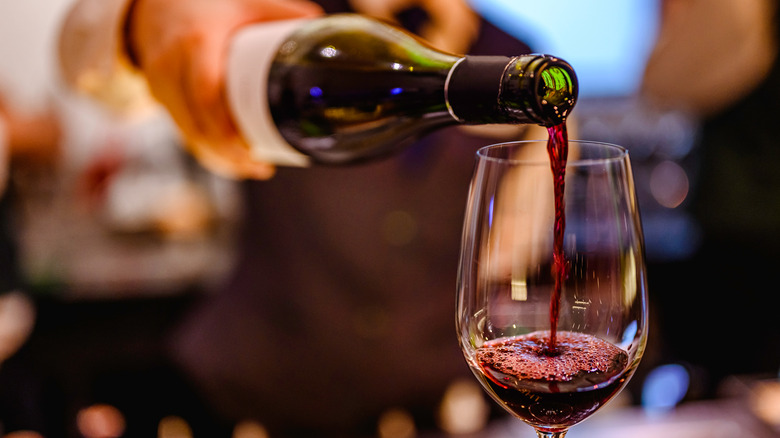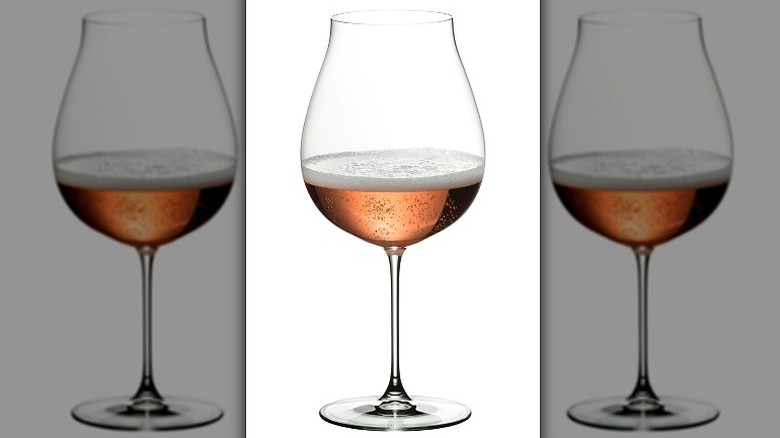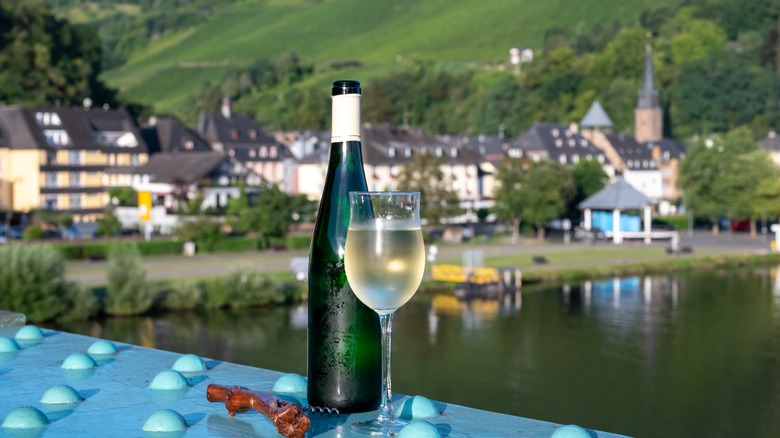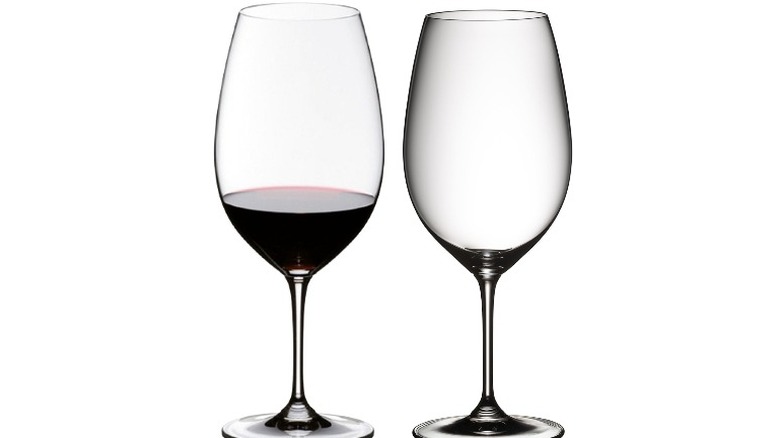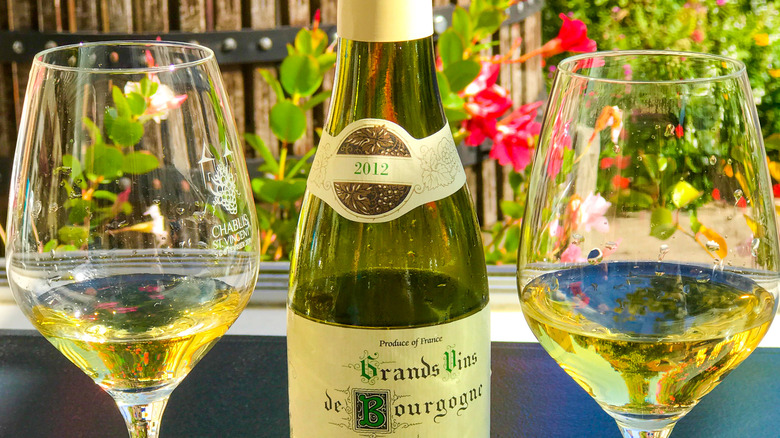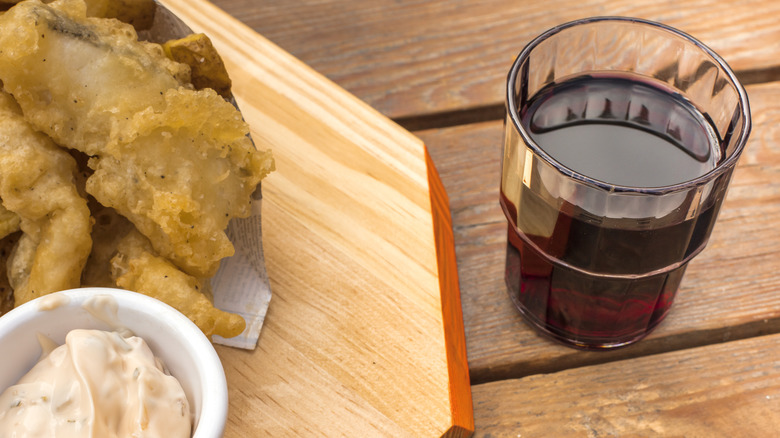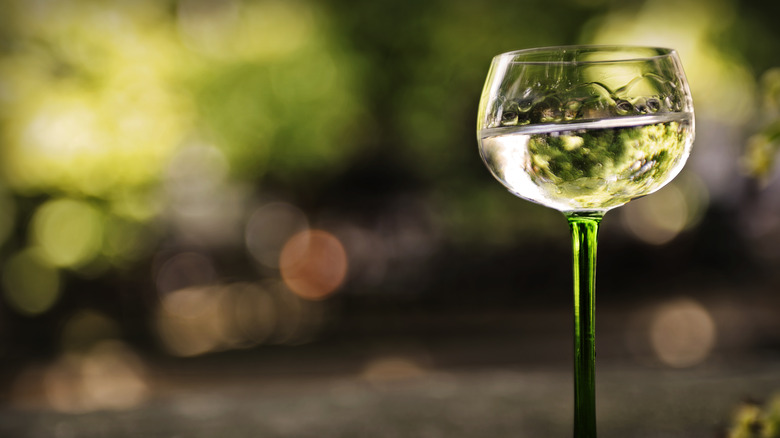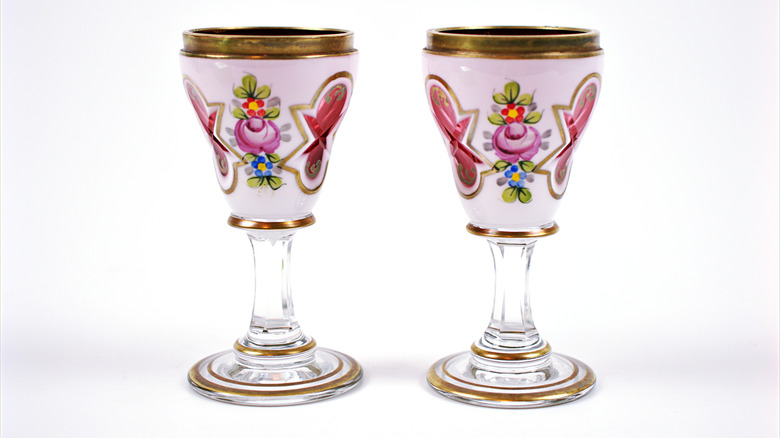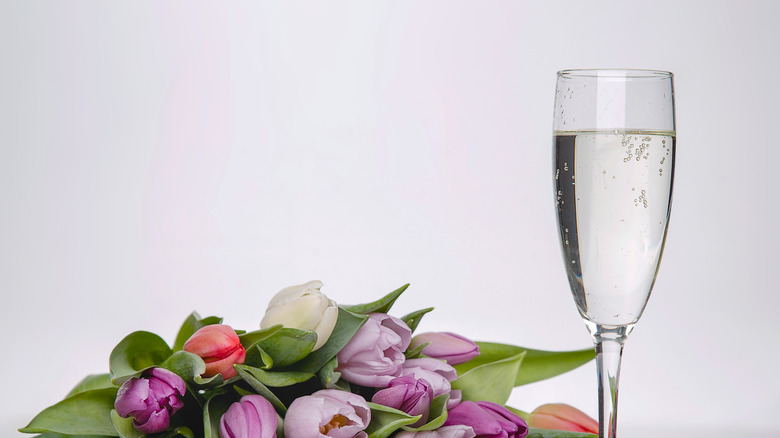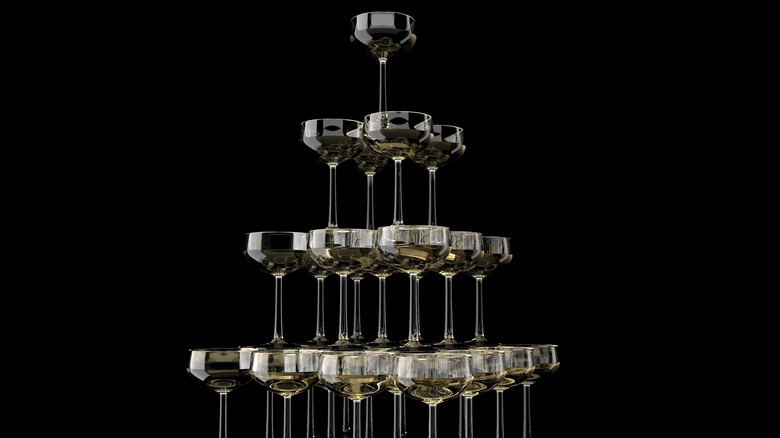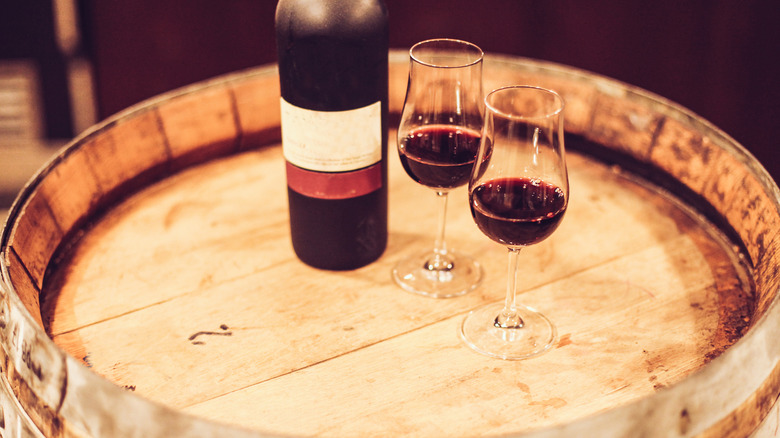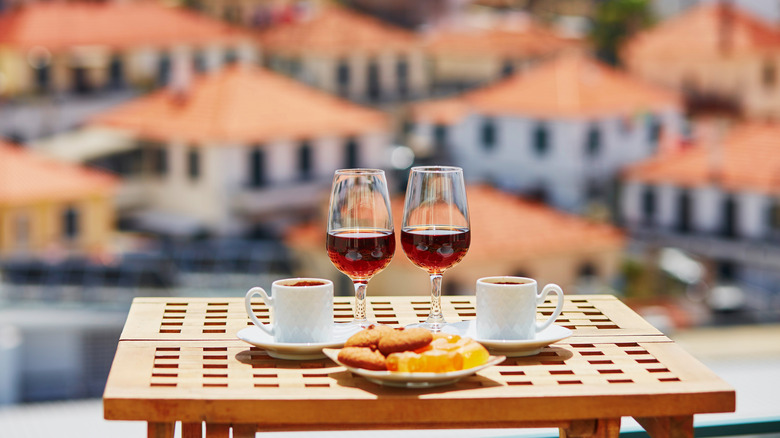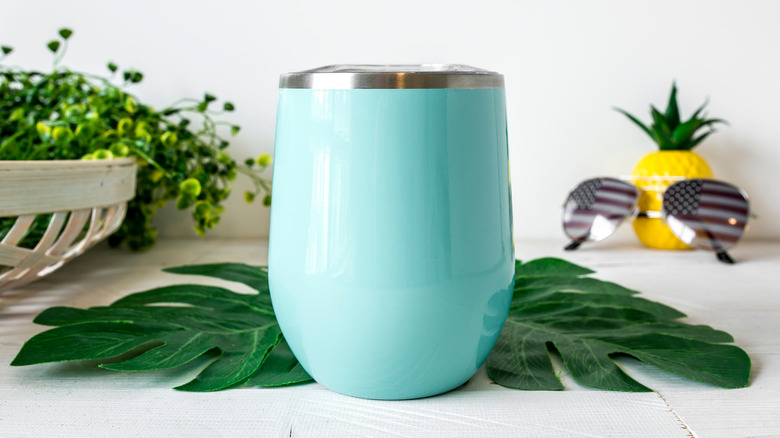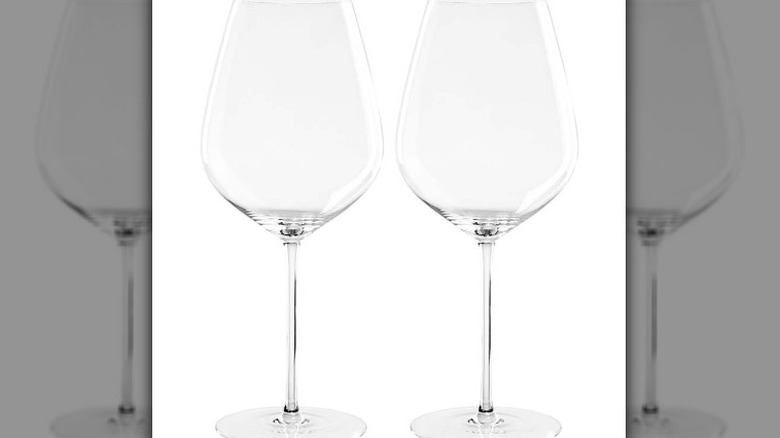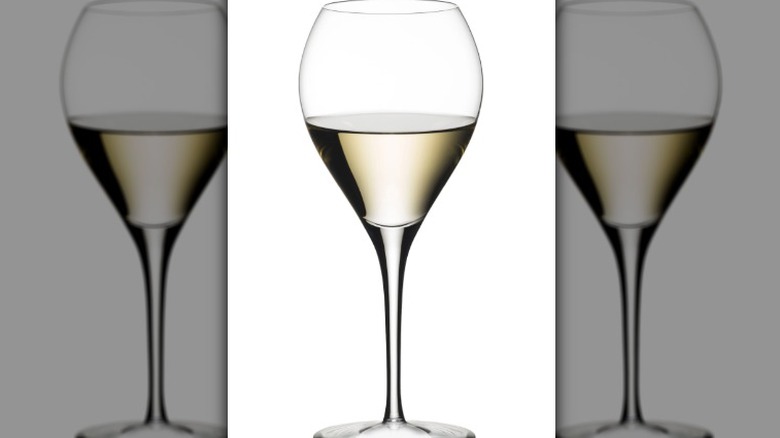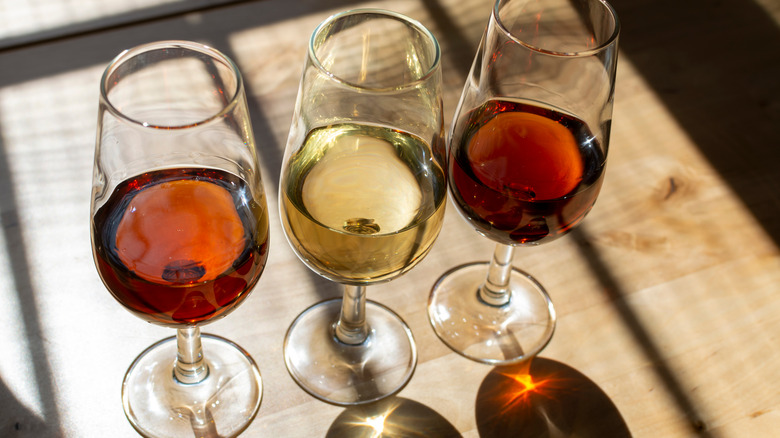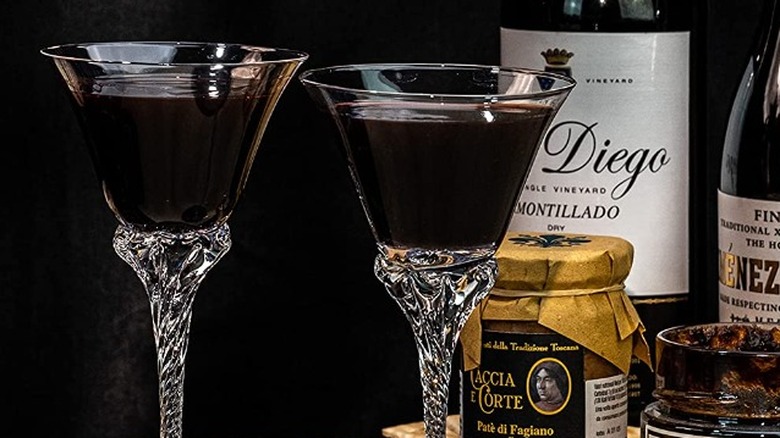20 Types Of Wine Glasses Explained
We may receive a commission on purchases made from links.
Finding the right wine glass can be daunting. Luckily it's not a deal-breaker to enjoy your wine from any old cup. No one will throw you in jail for drinking sauvignon blanc out of a Burgundy glass, but there is a science behind the different styles. There is a sense of ceremony when drinking wine from a well-made glass. Wine glass designers and makers such as Riedel have perfected this art for centuries. Modern companies, like Glasvin, are newer on the scene, shaking things up with a more attractive price point. Glass can be mouth or machine-blown. Some makers like Zalto are known for their feather-light designs. There is an abundance of makers for a reason; shape, size, and design all come to play a part in choosing your special type of wine glass.
Wineware relays the importance of each of the three parts that make up a stemmed wine glass — the base, stem, and bowl. The base (or foot as some know it) keeps the glass upright. The bowl holds the wine. In some cases, the stem joins the two. According to Riedel, different glass styles are specially designed to translate the message of wine to the human senses. So, before you consider many aspects of drinking wine, an early choice is between stemmed or stemless wine glasses.
Stemless vessels have a base underneath the bowl to keep the glass standing up. While not necessary, the stems serve a purpose. The stem is where we hold the glass without allowing the warmth of one's hands to affect the temperature of the wine. Riedel suggests accounting for three variables — shape, size, and rim diameter when considering the bowl. For serving, Wineware recommends filling to the widest point of the bowl to aerate the wine and allow for the aromas to unleash. Fortunately, there are many different glass styles to try.
Cabernet Sauvignon and Merlot
The merlot or cabernet sauvignon glasses are pieces you'll likely find at upscale steakhouses, next to that bold and expressive bottle of cabernet or merlot decanted and placed along with your porterhouse. Of course, an empty glass is a glass that's ready to be enjoyed. Forbes explains that the shape of the glass especially accentuates the aroma and tastes that are highly concentrated in cabernet sauvignon. Since cabernet and merlot are both on the full-bodied spectrum of red wine and are also high in polyphenols compound (tannins), a similar glass aids both.
The bowl is wide for the cabernet and merlot glass, allowing fragrances to develop and rough tannins to soften more readily through aeration (via Wine Enthusiast). The bowl's height permits these styles of wine (which tend to be high in alcohol) to release blooming aromas before they make it into the user's nostrils, per Forbes. Ideally, a well-crafted version of this style will effortlessly smooth over bitterness to be replaced by stand-out fruit aromas and flavors.
Red Burgundy (Pinot Noir)
Shaped similarly to a broad teardrop, a pinot noir/Burgundy glass is wide with a tapered rim. Per information from glassmaker Riedel, this design puts a spotlight on fresh fruit aromas, as they are concentrated in the bowl before being channeled through the rim, which is relatively narrow compared to a cabernet sauvignon glass and wide versus a Bordeaux (via Usual Wines). Accordingly, the large surface area of the bowl allows more oxygen to reach the wine (via Wine Enthusiast).
The slightly tapered rim is said to direct the aromas directly to your olfactory senses upon proper aeration. Wineware notes that the shorter stem and wide bowl also help collect the more spirited scents while leading the intense flavors to the correct part of your tongue. This glass is also said to temper the effects of high acidity. Pinot noir is the only red grape used in Burgundy, but according to Riedel, this glass style is great for any light-bodied red wine with similar acidity and tannin levels. So bring on the Gamay, Zweigelt, St. Laurent, and Nebbiolo.
Bordeaux
Bordeaux reds are mostly cabernet sauvignon and merlot grapes, so wine drinkers could certainly employ a cabernet/merlot glass here (via VinePair). The main intent of a specific "Bordeaux" glass is to amplify the earthy, old-world style of wines made in Bordeaux as compared to, say, a more modern Napa Cabernet. A 2015 study from the journal Analyst established that various types of wine evaporate disparately. Shapes of glassware capture it in different ways. Researchers discovered that cabernet sauvignon vapors tend to spread out more than other varieties. You can see how the vapor spread differs in these images from his "sniffer camera," courtesy of All Wine Tours.
Riedel sells a Bordeaux Grand Cru glass that they offer as the perfect vessel for full-bodied, complex red wines high in tannin. They explain that Claus J. Riedel designed this original wine glass to emphasize fruit, soften harsh tannins and balance a wine. The tall glass size, long stem, and wide bowl with tapered rim allow the bouquet to develop fully, and as the vapors spread throughout the glass, any roughness is eliminated.
Delicate New World Styles
These bulbous, tulip-shaped glasses are great for lighter styles of reds, rosés, and some whites. In the wine world, when speaking about New World and Old World, Old World wine regions are the regions where winemaking originated and has been operating continuously — think France, Italy, Germany, etc. New World regions are areas such as Napa, California, and the Willamette Valley in Oregon, for example. Wine Folly does a great job breaking down the differences, which are exactly what they might sound like; Old World wines are pastoral, with less of a fruit note, body, and richness.
New World wines are less rustic and sometimes aged in new oak, imparting many additional flavors like vanilla and cedar. The same grape made in an Old World region will taste vastly different from a New World iteration — hence the need for a different glass. This glass style perfectly showcases the fresh fruit and delicate style of light-bodied wines from the New World. Riedel explains that a tulip bowl and slightly flared lip help balance a wine by understating the alcohol and setting it according to the acidity. Aromatics are highlighted to bring out more demure wines. This glass style is also well suited for blooming the olfactory notes of rosé Champagne wines.
Riesling and Sauvignon Blanc
Both riesling and sauvignon blanc grapes have racy acidity (according to Usual Wines) and plush fruit flavors sought after by fans of that style. When it comes to riesling, experts on the matter defend drinking out of a Burgundy glass, which is larger (via Decanter). They claim that volatile compounds will rise out of a larger glass more readily because of the increased surface area. Wine Enthusiast suggests that the floral and citrus aroma found in riesling and sauvignon blanc grapes comes from terpenes. Their level of concentration is important to how we taste them.
That said, some glass producers see it differently and feel that the best style for these types of wines is one with a smaller bowl design. Wineware claims that the smaller bowl lowers the amount of oxygen in the glass so that it is easier to pick up on the rich concentration of terpenes in a riesling or sauvignon blanc. And according to Chicago Tribune, that furled tulip lip has been the traditional style for riesling in particular. In our perspective, this helps the flow of the wine wash into your sense of taste and smell.
Syrah (Shiraz)
Syrah (called shiraz in Australia) is known for having very full tannins and a lot of peppery and spicy notes. A syrah glass has a healthy volume, a slightly thinner bowl than a Bordeaux glass, and with a pinched lip, it could be called egg-shaped (via Wineware). This structure is important for mitigating syrah's high tannins and balancing aromas and flavors, per Riedel. Syrah is also loved for its silky, velvety body, and it's important not to lose these features when working to stabilize a wine.
When a wine has particularly coarse tannins, it can feel astringent and parching, almost like drinking an overly steeped black tea (which is also very tannic). The syrah type of wine glass is taller than a cabernet sauvignon glass and works to balance the body and smooth out rough tannins without losing the finesse, according to Wine Enthusiast. Its oblong bowl accents the soft fruit, earthiness, and black pepper notes, letting them roll out onto a long finish along high walls.
White Burgundy (Chardonnay)
If you don't already have Riesling in it, pour some chardonnay into this glass goblet and allow the self-expression to bloom. Chablis is chardonnay grown in the Chablis region of France — which is in Burgundy (via Wine Folly). It is very different in style from a Napa Chardonnay. The Three Drinkers does a great job of explaining the differences. In Chablis, they typically do not use new oak, which adds those buttery, vanilla flavors found in many other American or French chardonnays.
The design of a white Burgundy glass is similar to the red Burgundy glass but decreased in size and has a smaller stem. According to Business Insider, glasses designed for chardonnay should showcase a larger bowl, ideal for full-bodied white wines so as to utilize the expanded surface area. The volume and diameter make this design key for oak-aged chardonnay, viognier, petit manseng, and any other white wine with similar plush body or textural attributes. This type of glass is the perfect way for orange wine fans to accentuate such a layered and complex vino, per Wine Lover Magazine.
Chatos
Unlike any of the other styles we discussed, a chatos glass is a short, flat glass that almost resembles a juice cup. Foreigners are often shocked when their wine arrives in low, uncurved glasses instead of the goblets they might be used to, according to Spanish Wine Experience. Across the country, these glasses have different names, but chatos or txikitos are the two most common.
Hailing from the Basque region of Spain, Beautiful Basque Country says that this type of wine glass wasn't designed as a drinking vessel but as candle holders for the parade of Queen María Cristina, which took place in Bilbao at the beginning of the 20th century. After the parade, the Bilbao council didn't know what to do with all those glasses, and thus they were given to the city bars, which started serving wine in them with instant success. Enjoy a rich glass of tempranillo or a refreshing verdejo in your chatos glass.
Alsace
Alsace is a region in France that borders Germany, and as such, it has a lot of German influence. The grapes grown in this region are also popular in both countries — Riesling, pinot grigio, and gewürztraminer are all vinified dry with ease in this shared climate. At first, traditional Alsace glasses might look a little kitschy with a long, thick stem that almost mimics the tall, slim green bottles for which Alsace wine is famous. A large base is also bright green, yet the Alsace bowl is wide and short.
Alsace glasses are historically decorated with special "Hansi" drawings, popularized by an Alsation illustrator named Uncle Hansi. The images usually depict children holding hands around the glass, and Deco Alsace Obernai claims the storied design plays an essential role in the perception of taste. These days, however, wine enthusiasts can find traditional glasses on eBay more often than at wine bars. Riedel has an updated version of the Alsace glass that sadly is devoid of bright green stems or charming pictures.
Hock
According to Leaf, hock is the term for German white wine. So, in a way, any glass made for white wine could be called a hock glass. Really, an actual hock glass is a stylish sipper that has been beautifully etched with ornate designs. At first, glassmakers created this glass style with a kaleidoscope of colors — and much bigger. Leaf writes that some hock glasses were close to ¼ liter in size. However, modern designs have made the hock smaller in size and clear crystal to show the wine's hue.
Leaf writes that fancy hock glasses date from a time when wine was a delicacy. They were used as a display to show off the stylish etching and were often used. Sadly these stunners were not doing the wine any favors as far as amplifying taste or aromas and have mostly been replaced by modern designs. Hock glasses are widest at the top of the bowl and are a poor way to best capture the aroma or subtle notes of a wine.
All-Purpose
All-purpose is what you'll find in most restaurants and homes because they were specifically designed to accentuate all styles of wine and are generally cost-effective. Having a full range of glasses doesn't make sense for the average consumer (or cabinet)! Plus, when it comes to entertaining and catering to a wide variety of wine preferences, the bowl and the stem of a universal glass are medium in size and specifically designed to meet the needs of reds, whites, and even sparkling wines (via Glass.com).
While an all-purpose style is said to cater to all wine styles, there are also universal styles for each basic category of wine — red, white, sparkling, and dessert. According to a clarification from Glass.com, universal red glasses are medium-sized and have a wider and taller bowl than a white general purpose glass. The universal white glasses benefit from shorter bowls so that the delicate aromas are not too far from the consumer's nose and not diluted.
Because of the popularity of this style of glasses, most glass companies carry at least one. There's Riedel's All Purpose glass, Zalto's Universal glass, and Gabriel-Glas's One Glass For All, among many others. These have a good perception to wine professionals and are often the glasses used in trade tastings and events.
Champagne Flute and Tulip
Cheers! Perfect for clinking glasses on New Year's Eve — what would Champagne be without the Champagne flute? Using a wide glass for sparkling wine can cause the bubbles to dwindle quickly, and what's the point of sparkling wine without the sparkle? While some declare the coup to be the best vessel for your bubbles, Jamison Fink explains why the flute is here to stay.
The champagne flute is tall and narrow, a design style that is said to properly preserves carbonation. Bubbles congregate at the bottom of the glass and rise smoothly to the top — almost like a lava lamp. The flute became so synonymous with Champagne that Riedel even released a specific line of Dom Perignon glasses. Wineware points out that there is a difference between a Champagne flute and a tulip glass.
The flute has straight sides with a smaller surface area so that the aromas and fizz are concentrated. Whereas a tulip Champagne glass has a more modern look and a wider base for better aeration, ending in a rolling style off the lip to increase flow. These glasses are not just for Champagne, though — any type of bubbles can benefit from a Champagne glass — pop open some Cava, Prosecco, or Franciacorta.
Coupe
The coupe is a short and squat vintage-style glass once rumored to be a homage to Marie Antoinette's bosom. Ever since Leonardo DiCaprio raised one in a toast as Jay Gatsby, this glass has roared back into style. Before flutes developed in the 1920s, coupe glasses were all the rage. According to Advanced Mixology, the coupe originated in England in the late 1830s as the first official Champagne glass. But vintage fashion tends to come back into style. The coupe is seeing a rise in popularity again, so you may attend a party with a pyramid of coupes gathering flowing champagne in the near future (this VinePair article even tells you how to make one).
These glasses are usually rimmed with gold leaf and make for a beautiful statement piece. While the flute might be better at maintaining effervescence, Invaluable suggests that the coupe excels at amplifying the fruit characters of your bubbly (as well as the aesthetics). They also mention that coupe glasses actually de-accentuated the traits of autolytic wines, a process that is essential to the character of mature Champagnes. Save the flutes for your fine and aged sparkling wine, and use the coupe when going for inexpensive style.
Port Glass
Port is a fortified, red dessert wine (some varieties can be white or rosé) from Portugal (via Wine Folly). It is a drink typically enjoyed after dinner or alongside dessert. Port tastes unctuous and rich, so a little bit goes a long way (a standard pour is about 3 ounces). Robb Report explains why it is best to enjoy port out of a specified glass by writing that a port glass is pretty much a smaller version of your typical wine glass. As a digestif, port wine is highly revered, and the specifically designed aspects of its glass bring out its intricacies.
Port glasses feature a small bowl and narrow rim to concentrate the port's bouquet. They are stemmed so as to not warm your glass beyond the ideal serving temperature, which differs between whites, reds, and tawny (via Calem Porto). Don't look perplexed if you fail to pass the bottle of port and a fellow diner asks if you know the Bishop of Norwich. According to Taylor Fladgate, this is an old British tradition that serves as a gentle reminder to get the decanter moving again.
Madeira
Madeira wine (and wine glass style) hails from the Portuguese island of Madeira and is a fortified dessert wine that is usually red, though white or rosé Madeiras can be found. The difference between Madeira and Port is how it is made. According to Taste of Lisboa, the production method — using high heat over multiple months — gives it a more complex flavor profile than port. Madeira is served in small 75 to 120 milliliters (3 to 4 ounces) wine glasses, however, Bespoke Unit suggests serving it in traditional copita nosing glasses (typically used for Scotch). Specially crafted styles can feature a glass cover to help capture the aromas before enjoying them.
While Bespoke Unit writes that copita glasses often feature a more pronounced tulip shape which helps accentuate the bouquet, The New York Times believes that the shape of a standard wine glass is better suited to Madeira wine. Vintage Madeira glasses were previously made in various colors and shapes, but newer designs are clear so that imbibers can see the beautiful deep brick color of their beverage.
Stemless or Outdoor Tumbler
Sick of broken wine glasses? Want something to take camping or to a picnic? There is a reason stemless glasses are so sought after. While stems certainly have their place, sometimes a simple design is best. A stemless glass is exactly what it sounds like. Instead of a stem and base, these glasses are flat on the bottom of the bowl so the glass can sit upright. For outdoor use, Liquor.com recommends tumblers made of stainless steel as a great option — they even come with a lid to prevent spills and keep the bugs out. Many are insulated to keep your beverage cold as well. Most are made with the universal wine glass shape in mind.
When it comes to using glass stems in everyday scenarios, there is much debate whether this should be an accepted mode of enjoying wine, despite its popularity. Wineware laid out all the pros and cons, saying that although they are more modern and chic, there is less of a chance of breakage, and storing them is much easier, there are still reasons some consumers and professionals won't warm up to the idea. In fact, warming up is one of those reasons —when serving wine in a stemless glass, the heat from your hands can increase the temperature of your drink, affecting the expression.
Oversized
We have all had those days where we want to settle in and decompress with a massive glass of wine, àla Amy Schumer. An oversized glass may be impressive to look at. It will even lessen the number of times you need to pause Netflix, get up, and go to the counter for another pour. But there are further reasons that support using the larger-than-life bowl. For big, bold, dry reds, the maximum aeration area will smooth and round out even the roughest tannins.
Crystal makers Big Wine Glasses even claim that this style is the perfect universal glass, shaped to fit whatever type of wine you prefer. With 34-ounces of volume, their oversized glass will save you a trip and keep your tastebuds from encountering any bitter sips. We've all seen the comically large glasses over at Costco, which can fill run upwards of 4-foot tall. While that will definitely give even the boldest wine time to balance before it hits your lips, a more practical volume makes the oversized wine glass style a reasonable choice.
Sauternes
Sauternes is a luxurious (in price and flavor) white dessert wine from the Bordeaux region of France. Made with sauvignon blanc and sémillon, this gorgeous wine is sticky-sweet with notes of marmalade, ginger, honeyed apricot, and citrus according to Wine Folly. The sweetness is balanced with its naturally vibrant acidity. This is the goal for dessert wines — to register as compelling but not cloying. Respective glasses emphasize acidity, and crafters like Riedel have honed in on what makes a good Sauternes glass.
Most dessert wine glasses are slimmer in shape than a standard wine glass but wider than a Champagne flute, per Robb Report. They explain that — as with all glass designs — dessert styles should showcase both the flavor and aromas of this specific sect of wine. In dessert wine glasses, the bowl is just broad enough to allow for the expression of sweetness while slim enough to balance it with acidity. Specifically, the bowl of the Sauternes glass narrows, then widens, and then narrows again (via Dimensions.com). Per Riedel, this shape underscores acidity in companion with pleasing sweet accents.
Sherry Clipper
Sherry is a deeply complex wine from Spain made in three styles — dry sherry wines, naturally sweet wines, and sweet sherry wines (via Sherry Notes). Depending on if they are biologically aged or oxidatively aged, they can be nutty and brooding or refreshing with green apple notes. They go through an intricate barrel aging and blending system called solera. Similar to port wine, sherry is often consumed with dessert. Per Wazee Supper Club, the most suitable sherry glasses are similarly bulbous to allow for a marriage of aroma and taste.
Sherry can run the gamut of colors, flavors, and sweetness levels, but its calling card is its savory saline note and a hint of umami. The Sherry Clipper is named for the type of ship that used to import sherry from Spain, according to Savage Vines. It is a small glass with a narrow bottom that expands and tapers to the lip of the glass (via Dimensions.com). It's recommended to serve sherry in a chilled glass, and thanks to the Clipper's stem, you won't have to worry about residual heat warming your beverage.
Sherry Schooner
Also named for another type of ship used to import sherry — the Schooner is a larger companion to the Clipper. As explained by Savage Vines, generally, the Schooner is what you'd think of when it comes to sherry glasses. They have the same narrow bottom and expanding bowl as a Clipper, but the lip continues to a fuller tulip shape. A Schooner glass is still smaller in volume than your average wine glass.
Consider if a chatos glass and a universal wine glass were merged together. The idea behind the design is that a smaller sherry glass with a wide rim allows for the sherry to breathe and oxidize while a large bowl promotes a mingling of heady notes. The tulip lip allows it all to roll out like a wave over your senses. This relatively small glass should not be confused with a Schooner beer glass, which is a massive, bowled glass that holds nearly three pints of beer!
